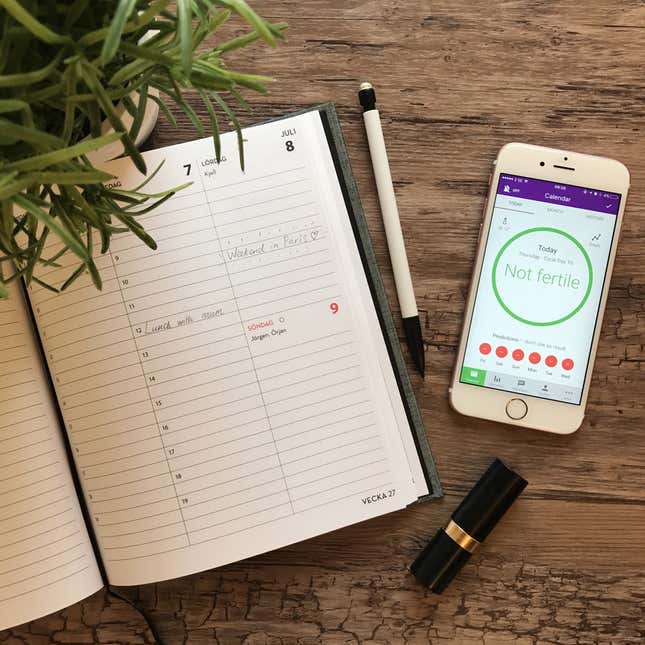A slender white woman in a black bathing suit teeters on the edge of a deck in the Maldives. She looks down—not at the crystal water, but at her phone. “Back to basics,” the Instagram caption of the photo reads, inviting the viewer to click through to a YouTube video detailing @josieldn‘s favorite self care routines. Among them: “self love, natural beauty tips … and a game-changing new app @naturalcycles.”
It would be easy to miss the obligatory hashtag appended to the end of the caption—“#ad”—and think this a standard post from an Instagram “influencer.” A London-based fashion blogger with 119,000 followers, @josieldn was paid to post her endorsement by Natural Cycles, an app launched in 2014 in Sweden which promotes itself as “the only certified contraceptive app” on the market. Across the globe, Natural Cycles has 600,000 users, roughly 75% of them using it to prevent pregnancy. (There is also a mode for those who want to get pregnant.)
Natural Cycles works by asking users to log their basal body (BBT) temperature at the same time each day (a woman’s temperature increases slightly right after ovulation), and then feeding that data into an algorithm which predicts whether or not she could get pregnant from unprotected sex that day. The more information a user inputs over several cycles, the better the algorithm gets at predicting her fertile window each month, which starts about five days before ovulation, and includes the 24 hours after. It is the only app certified as contraception in the EU and though it already has users in the US, it is reportedly seeking government approval so it can be marketed as a contraceptive there, instead of just as a fertility monitor.
While Natural Cycles is far from the only fertility app on the market, it’s safe to say it has the most aggressive influencer marketing strategy of them all. A search of the hashtag on Instagram will produce dozens of enviable images with captions in both English and Swedish, uploaded by fresh-faced fashion, wellness, and lifestyle influencers and bloggers talking about why they’ve gone #hormonefree.

Natural Cycles and similar apps have given women yet another option when it comes to preventing pregnancy—and for women who have had bad experiences with hormonal birth control methods or prefer not to implant an IUD, fertility tracking can be a godsend. But they’ve done something else, too: They’ve become a lifestyle goal. And in a culture obsessed with elimination as a form of aspiration—be it dairy, screen time, chemicals, or gluten—the fertility-tracking movement has inadvertently framed hormonal birth control as something to avoid.
Lately, among a certain set of women, forswearing the pill seems to have shifted from a personal preference to an identity statement. I first got interested in this topic myself when I noticed several girlfriends verbally expressing surprise that I was “still on the pill.” Soon, I couldn’t go on Instagram without being urged to practice self-care via a fertility-tracking app. Had I missed the memo that hormones are so terrible?
They’re not. Indeed, they are remarkably safe, and since the pill was first introduced in 1960, they have given women unprecedented control over their own fertility. Though they don’t work for everyone, for tens of millions of women who use them, they have few ill effects.
And while every woman should choose the method of contraception that’s right for her, using the hugely aspirational medium of social media to subtly suggest that a “hormone-free” life is a better or more natural one—without providing honest context about just who it is for and who it is not—is different. This movement arrives at a time when women’s bodies, diets, and choices around whether and when to have children are already judged enough.
Pro-Kale, Anti-Hormones
Fertility tracking has been around since two scientists, one Japanese and one Austrian, discovered separately in the 1930s that ovulation occurs on one day of a woman’s cycle—thereby indicating that about three weeks (give or take) of a woman’s cycle were “safe” for unprotected sex without fear of pregnancy.
Natural family planning, including the calendar-based “rhythm method,” has historically been associated with the Catholic church. Today’s fertility apps are sold as a tech-enabled (and therefore, in theory, more accurate) version of that early approach. That a method to prevent pregnancy could evolve from something vaguely explained in my 12th-grade religion class by a nun to a bona fide Instagram lifestyle trend is surprising—and it did not happen overnight.

The shift came about in part because of a backlash to the pill. While the scientific community is in broad agreement that hormonal birth control is safe for the 140 million worldwide who use it, it is undeniable that it does not work well for everyone. For some, it causes severe physical, mental, or emotional symptoms. Others worry about conflicting studies on the pill’s links to depression, or don’t want to rely on the profit-driven pharmaceutical industry. And many women feel ignored or mistreated by the medical system as a whole.
In 2010, as the the pill celebrated its fiftieth birthday, the culture journalist Vanessa Grigoriadis wrote a feature in New York Magazine lamenting that while many women spend their 20s and early 30s reveling in the sexual freedom the pill allows, “the cost” eventually catches up to them: “For women who have spent so much of their lives pressing the off button on their bodies while on the pill, it’s upsetting to learn that there’s no magic pill that causes instant impregnation.”
Grigoriadis made clear in her piece that the pill does not cause the problems conceiving that some older women face, but she does suggest that ingesting the pill for years or decades leaves women in a state of blissful ignorance about what’s really going on with their bodies—”the biological realities of being female.” If they come off the pill and find there have been underlying issues all along, she says, they also find their time to fix the problem is limited.
By 2013, the journalist Ann Friedman had noticed an attitude shift among certain privileged women. They weren’t just coming off the pill when they were ready to get pregnant, she pointed out in a piece for The Cut. They were joining the “pullout generation” way before that—often while in stable relationships—because they were tired of taking hormones. And if they got pregnant because the pullout method failed them? It’s a risk they were willing to take:
These women describe a deliberate transition from the pill to the pullout. They buy organic kale and all-natural cleaning products, and so can’t quite get down with taking synthetic hormones every day … They’re sick of supposedly egalitarian relationships in which they bear the sole responsibility for staying baby-free … And despite the fact that non-hormonal contraceptive options remain frustratingly limited, there are new tools at their disposal: With period-tracker apps, charting your menstrual cycle is no longer the domain of hippies and IVF patients.
The idea of “getting to know your body” falls right in line with the wider cultural moment. In a world where women are acutely aware of the ways their bodies are violated, legislated, and objectified, it’s easy to see the appeal—and indeed, the somewhat radical nature—of getting intimately acquainted with one’s own.
That terrain is not limited to people using fertility tracking to avoid pregnancy or rejecting the pill. Period-tracking apps like Clue (which are not the same as fertility awareness apps, and thus are expressly not marketed as contraception) have settings designed for women on the pill. And women who don’t have sex with men or risk unintentional pregnancy still have compelling reasons to track their cycles.
IRL versus an app
In addition to being the most Instagrammed fertility app, Natural Cycles has recently become the most controversial. In January, one of Stockholm’s largest hospitals noted that 37 out of the 668 women who sought abortions over a four-month period in 2017 got pregnant while using the app to prevent pregnancy. The hospital reported the findings, and an investigation was launched by the Swedish Medical Products Agency (MPA).
In response to the investigation, Natural Cycles issued a statement matter-of-factly pointing out that the number of unintended pregnancies was “well in line with our expectations, given our efficacy rate of 93% for typical use.” Still, the MPA’s investigation is ongoing, Quartz confirmed.
Dr. Marguerite Duane is an adjunct associate professor at Georgetown University’s Department of Family Medicine and the executive director of FACTS—which stands for Fertility Appreciation Collaboration to Teach the Science—an organization that seeks to educate health professionals and students about the science underlying fertility awareness based methods, or FABM. She says that due to the method’s association with the Catholic church, critics are often quick to point to the inefficacy of FABM. (While Duane herself is Catholic, the FACTS organization has no faith-based affiliation.)
We should be able to critique apps claiming to work as birth control without critiquing FABM at large, Duane argues. And indeed in 2016, Duane and her colleagues published a peer-reviewed paper in the Journal of the American Board of Family Medicine ranking various fertility apps and dismissing many of them as ineffective for contraceptive purposes. Of the 95 apps they reviewed, 55 were eliminated from the study because they were not relying on an evidence-based method for identifying the fertile window, or because they had a disclaimer saying they should not be used to prevent pregnancy. The study concluded that “the majority of fertility apps are neither designed for avoiding pregnancy nor founded on evidence-based FABMs.”
At the time, Natural Cycles had a proprietary algorithm, resulting in a lower score in the study. Since then, Natural Cycles has released a prospective study, which means it is the first app to have looked at a cohort of women over a period of time to determine effectiveness—rather than simply retroactively surveying its users to determine efficacy. The study was published in the peer-reviewed journal Contraception, with Natural Cycle’s founder Dr Elina Berglund as the lead author. It found an effectiveness rate of 93% with “typical use,”—which accounts for human error—based on what’s called the Pearl Index. This is comparable with the typical use effectiveness rate of other forms of contraception. However long-acting reversible forms, such as the copper or hormonal IUD, tend to have a higher typical use effectiveness rate because they’re harder to mess up.
So given all her research, how does Duane feel about Natural Cycles now? “Now that they’ve done a prospective study, I am fairly pleased. I think that’s probably accurate and it’s comparable to the effectiveness studies of natural methods that aren’t taught with an app.”
“Natural methods that aren’t taught with an app” is a key caveat, though. Fertility tracking methods to prevent pregnancy are not all created equal, and can vary in complexity and effectiveness, with methods like the calendar rhythm being the highest risk, as it relies on a woman having an extremely regular cycle. Among the most effective, according to research, is the sympto-thermal, wherein cervical mucus is examined daily for signs of ovulation in addition to the basal body temperature method that Natural Cycles uses.
It’s important to note that there are not many high quality studies examining the effectiveness of the BBT and algorithm method on its own. Duane points out that “the highest quality studies showing the effectiveness of FABMs looked at couples that learned how to use the method from trained instructors.”
In essence, fertility tracking is hard to master without feedback or a proper baseline understanding of how conception works, as well as a willing and motivated partner. The best apps, Duane says, are ones that encourage users to seek trained instruction first—especially to help learn how to manually track cervical mucus signs, which Duane admits can make some women squeamish—and then use the app as an maintenance tool. These include apps like Kindara, CycleProGo, and Fertility Pinpoint.
Regarding the 37 women who got pregnant using Natural Cycles in Sweden, Duane says that number could very well be in line with Natural Cycle’s published efficacy rate, but more information is needed to find out for sure. It’s hard to judge how egregious that number of pregnancies is without knowing how many women were using the app in the area—the denominator to that 37—which hasn’t been made public.
Conditions Apply
When you look closer, Natural Cycles is pretty narrowly prescriptive about who should use its app. For one thing, single women need not apply. On its website FAQ, Natural Cycles says the ideal users are “women between the ages of 20-40 who are in a stable relationship, comfortable with using protection (condoms) on red days and don’t mind measuring their temperature in the morning.”
In 2016 piece in the Guardian, Natural Cycles researcher Kristina Gemzell Danielsson also suggests they should be prepared for the possibility that they’ll still get pregnant, pointing out “that it’s not a good option for women who absolutely want to avoid a pregnancy.” And she doesn’t recommend it for anyone who has “an irregular lifestyle”—presumably anyone having sex outside a monogamous relationship.
Using FABM as contraception may look aspirational on Instagram—but it is undeniably hard work, especially when compared to other forms of birth control. The basal body temperature tracking method assumes several things: You have a stable enough life to be able to wake up at roughly the same time every single day (and will remember to do a temperature reading before getting up to pee, cuddling your partner, or even sitting upright in bed). You don’t travel, have hangovers, stay up late working, sleep in, or get stressed too often—all of which can affect your temperature reading that day and when you ovulate that month, and thus render the algorithm less accurate. You and your partner are willing to commit to either abstaining from sex when you’re fertile—often when a woman’s libido is highest—or using a barrier method. And on top of all of that, you need to have total agency over whether a man has sex with you and when. (For many young women in the West, it’s perhaps too easy to ignore what life was like before the pill.)
Compared to those breezy ads on Instagram, this all seems like a pretty stringent criteria, and perhaps possible only for a segment of society. Higher educated women were more likely to use a calendar-based rhythm method, a 2013 CDC study found, with “2.9% of women in the lowest attaining education group [having] used natural family planning (basal body temperature or cervical mucus tests), compared with 12% of women with a master’s degree or higher.”
Perhaps that’s because wealthier women with higher education levels are more likely to have the stability and bandwidth to commit to FABM. More importantly, they also are likely to have better economic and medical choices if it fails—no small matter in countries like the US where reproductive healthcare can be prohibitively expensive and, in some states, scarce.
And those ads on Instagram? They come with no disclaimer mentioning that the app works best if you’re in a committed relationship with a supportive partner, nor the requirement that you’d be cool with an accidental pregnancy (though many do say that it’s for women aged 18+ and that it does not protect against STDs).
Natural Cycles declined to be interviewed for this piece, but the company responded to a series of emailed questions by saying that it does not have concerns around non-medical professionals advocating for contraceptive methods to potential users, nor does it worry about presenting the app with an aspirational framing.
“Influencers who use the app write about their personal experience,” the co-founder, Dr. Berglund, wrote. “If they have regular cycles and measure regularly, they will get green days faster, and the opposite is of course equally true. What’s important is that everyone gets to describe their journey with Natural Cycles, whether they use it to prevent or just get to know their bodies better.”
Dr. Berglund added that when it comes to the rather stringent lifestyle requirements described above, a woman with an “irregular lifestyle” would find she is more likely to to receive “red days,” or days when the app suggests she use a condom or abstain from sex if she’s trying to avoid pregnancy. But she emphasizes that’s not the same as the app’s effectiveness going down.
“This means effectiveness is not likely to go down, but the app will be less interesting as a contraceptive alternative, since the point is to get as many green days as possible.”
Free of gluten, dairy, and hormones
As the “clean eating” movement has taught us, framing a product as “free” of something often sets up that “something” as a thing to avoid—even when there is no real need for the majority of the population to do so. That is how “gluten-free” became a lifestyle choice and not a medical condition, and how sugar has been likened to everything from poison to crack cocaine, rather than something to consume in moderation. It’s also why some researchers are studying the link between social media use and orthorexia, an eating disorder characterized by a pathological fixation not on thinness, but on a clean and pure diet.

While it may be subtle, there’s an anecdotal effect this kind of framing can have. Georgia Scarr, a health journalist based in the UK, says she has seen “hormone shaming” become more prevalent in the wellness and fitness media—as well as in her own personal life—and thus she finds “Natural Cycles’ use of paid promotion via social media influencers … quite unsettling.”
Anita Mitra is a gynecologist for the UK’s National Health Service and also maintains a blog called ”Gynae Geek” about female reproductive health. She says that she has anecdotally observed an uptick in the number of women ashamed to be on the pill in her own practice. She worries that social media and myths—like the common notion that women should “take a break” from being on the pill once in a while—are to blame.
“Over the last three to four years I’ve noticed a dramatic trend towards women telling me they are on the pill with a real shame in their voice and a gaze that often cannot meet mine,” Mitra says. “There appears to be a feeling that taking the pill is the wrong thing to do, and also a huge misconception that taking it for a long time is unhealthy.”
It bears repeating that every woman should be empowered to choose whatever contraception method works for her. While apps can certainly be a great choice for some, Duane worries that spreading the word through sponsored Instagram posts may not fully convey the education and support needed to do FABM correctly.
“I do want to see these methods more widely available,” Duane says. “But I do have concerns that overselling it—’this is as easy as an app’—is actually going to lead to potentially more unintended pregnancies because people aren’t going to use them effectively.”
Fertility awareness-based apps probably aren’t right for a large majority of women who lead modern, busy lives, Mitra says. She worries that affiliating them with other wellness trends—i.e. saying they are part of a “natural” lifestyle, for instance—pressures women to try them anyway.
“No one should ever feel ashamed for wanting to use a reliable form of contraception,” she says. “Which is something I feel incredibly strongly about as someone who has to work with the distraught women who find themselves accidentally pregnant on a daily basis.”
Update: This story has been updated to accurately reflect Georgia Scarr’s job description.
